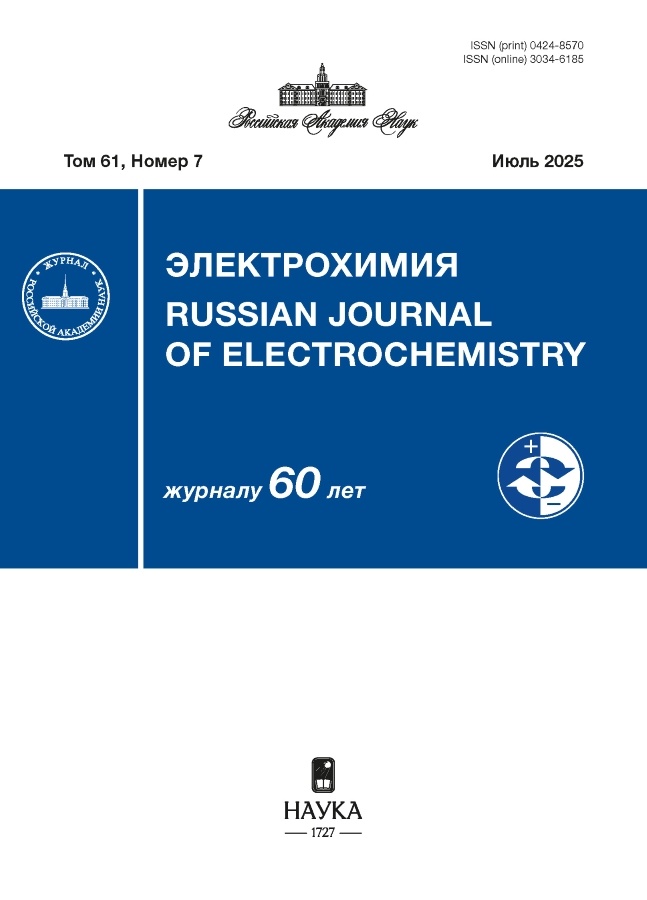Адсорбция полипротеина Gag вируса иммунодефицита человека на липидных мембранах: исследование методом компенсации внутримембранного поля
- Авторы: Дениева З.Г.1, Макринский К.И.1, Ермаков Ю.А.1, Батищев О.В.1
-
Учреждения:
- Институт физической химии и электрохимии им. А.Н. Фрумкина РАН
- Выпуск: Том 60, № 6 (2024)
- Страницы: 387-398
- Раздел: Статьи
- URL: https://modernonco.orscience.ru/0424-8570/article/view/671310
- DOI: https://doi.org/10.31857/S0424857024060019
- EDN: https://elibrary.ru/PVFDAZ
- ID: 671310
Цитировать
Полный текст
Аннотация
Полипротеин Gag – это основной структурный белок вируса иммунодефицита человека (ВИЧ). Он ответственен за сборку новых вирусных частиц в инфицированной клетке. Данный процесс происходит на плазматической мембране клетки и, во многом, регулируется взаимодействиями Gag с липидным матриксом клеточной мембраны. В настоящей работе с помощью метода компенсации внутримембранного поля и электрокинетических измерений дзета-потенциала в суспензии липосом нами было изучено связывание немиристоилированого полипротеина Gag ВИЧ с модельными липидными мембранами. Для количественной оценки аффинности белка к заряженным и незаряженным липидным бислоям были получены изотермы адсорбции Gag и вычислены константы связывания. Показано, что данный белок способен взаимодействовать с обоими типами мембран примерно с одинаковыми истинными константами связывания (KPC = 8 × 106 М–1 и KPS = 3 × 106 М–1). Однако присутствие в липидном бислое анионного липида фосфатидилсерина значительно усиливает адсорбцию белка на мембране за счет дополнительного влияния создаваемого им поверхностного скачка потенциала вблизи мембраны (KPSэфф = 37.2 × 106 М–1). Таким образом, взаимодействие Gag с мембранами определяется, скорее, гидрофобными взаимодействиями и площадью, приходящейся на одну липидную молекулу, в то время как наличие отрицательного поверхностного заряда лишь увеличивает концентрацию положительно заряженного белка вблизи мембраны.
Полный текст
Об авторах
З. Г. Дениева
Институт физической химии и электрохимии им. А.Н. Фрумкина РАН
Автор, ответственный за переписку.
Email: zaret03@mail.ru
Россия, Москва
К. И. Макринский
Институт физической химии и электрохимии им. А.Н. Фрумкина РАН
Email: zaret03@mail.ru
Россия, Москва
Ю. А. Ермаков
Институт физической химии и электрохимии им. А.Н. Фрумкина РАН
Email: zaret03@mail.ru
Россия, Москва
О. В. Батищев
Институт физической химии и электрохимии им. А.Н. Фрумкина РАН
Email: olegbati@gmail.com
Россия, Москва
Список литературы
- Bell, N.M. and Lever, A.M., HIV Gag polyprotein: processing and early viral particle assembly, Trends in microbiology, 2013, vol. 21, no. 3, p. 136. https://doi.org/10.1016/j.tim.2012.11.006
- Freed, E., HIV-1 assembly, release and maturation, Nat. Rev. Microbiol., 2015, vol. 13, p. 484. https://doi.org/10.1038/nrmicro3490
- Saad, J.S., Miller, J., Tai, J., Kim, A., Ghanam, R.H., and Summers, M.F., Structural basis for targeting HIV-1 Gag proteins to the plasma membrane for virus assembly, Proc. National Acad. Sci. United States of America, 2006, vol. 103, no. 30, p. 11364. https://doi.org/10.1073/pnas.0602818103
- Mercredi, P. Y., Bucca, N., Loeliger, B., Gaines, C.R., Mehta, M., Bhargava, P., Tedbury, P.R., Charlier, L., Floquet, N., Muriaux, D., Favard, C., Sanders, C.R., Freed, E.O., Marchant, J., and Summers, M.F., Structural and Molecular Determinants of Membrane Binding by the HIV-1 Matrix Protein, J. molecular biology, 2006, vol. 428, no. 8, p. 1637. https://doi.org/10.1016/j.jmb.2016.03.005
- Mammano, F., Ohagen, A., Höglund, S., and Göttlinger, H.G., Role of the major homology region of human immunodeficiency virus type 1 in virion morphogenesis, J. virology, 1994, vol. 68, no. 8, p. 4927. https://doi.org/10.1128/JVI.68.8.4927-4936.1994
- Dalton, A.K., Ako-Adjei, D., Murray, P.S., Murray, D., and Vogt, V.M., Electrostatic interactions drive membrane association of the human immunodeficiency virus type 1 Gag MA domain, J. virology, 2007, vol. 81, no. 12, p. 6434. https://doi.org/10.1128/JVI.02757-06.
- Chukkapalli, V., Hogue, I.B., Boyko, V., Hu, W.S., and Ono, A., Interaction between the human immunodeficiency virus type 1 Gag matrix domain and phosphatidylinositol-(4,5)-bisphosphate is essential for efficient gag membrane binding, J. virology, 2008, vol. 82, no. 5, p. 2405. https://doi.org/10.1128/JVI.01614-07
- Barros, M., Heinrich, F., Datta, S.A.K., Rein, A., Karageorgos, I., Nanda, H., and Lösche, M., Membrane Binding of HIV-1 Matrix Protein: Dependence on Bilayer Composition and Protein Lipidation, J. virology, 2016, vol. 90, no. 9, p. 4544. https://doi.org/10.1128/JVI.02820-15
- Freed, E.O., HIV-1 Gag: flipped out for PI(4,5)P(2), Proc. National Acad. Sci. United States of America, 2006, vol. 103, no. 30, p. 11101. https://doi.org/10.1073/pnas.0604715103
- Yeung, T., Heit, B., Dubuisson, J.F., Fairn, G.D., Chiu, B., Inman, R., Kapus, A., Swanson, M., and Grinstein, S., Contribution of phosphatidylserine to membrane surface charge and protein targeting during phagosome maturation, J. cell biology, 2009, vol. 185, no. 5, p. 917. https://doi.org/10.1083/jcb.200903020
- Ermakov, Y.A., Averbakh, A.Z., Yusipovich, A.I., and Sukharev, S., Dipole potentials indicate restructuring of the membrane interface induced by gadolinium and beryllium ions, Biophys. J., 2001, vol. 80, no. 4, p. 1851. https://doi.org/10.1016/S0006-3495(01)76155-3
- Ermakov, Y.A., Kamaraju, K., Sengupta, K., and Sukharev, S., Gadolinium ions block mechanosensitive channels by altering the packing and lateral pressure of anionic lipids, Biophysical Journal, 2010, vol. 98, no. 6, p. 1018. https://doi.org/10.1016/j.bpj.2009.11.044
- Marukovich, N., McMurray, M., Finogenova, O., Nesterenko, A., Batishchev, O., and Ermakov, Y., Interaction of Polylysines with the Surface of Lipid Membranes, Advances in Planar Lipid Bilayers and Liposomes, 2013, vol. 17, p. 139. https://doi.org/10.1016/B978-0-12-411516-3.00006-1.
- Ермаков, Ю.А., Соколов, В.С., Акимов, С.А., Батищев, О.В. Физико-химические и электрохимические аспекты функционирования биологических мембран. Журн. физ. химии. 2020. Т. 94. № 3. С. 342. [Ermakov, Y.A., Sokolov, V.S., Akimov, S.A., and Batishchev O.V., Physicochemical and Electrochemical Aspects of the Functioning of Biological Membranes, Russ. J. Phys. Chem., 2020, vol. 94, p. 471.] https://doi.org/10.1134/S0036024420030085
- Kempf, N., Postupalenko, V., Bora, S., Didier, P., Arntz, Y., de Rocquigny, H., and Mély, Y., The HIV-1 nucleocapsid protein recruits negatively charged lipids to ensure its optimal binding to lipid membranes, J. virology, 2015, vol. 89, no. 3, p. 1756. https://doi.org/10.1128/JVI.02931-14
- Perez-Caballero, D., Hatziioannou, T., Martin-Serrano, J., and Bieniasz, P. D., Human immunodeficiency virus type 1 matrix inhibits and confers cooperativity on gag precursor-membrane interactions, J. virology, 2004, vol. 78, no. 17, p. 9560. https://doi.org/10.1128/JVI.78.17.9560-9563.2004
- Ono, A., Demirov, D., and Freed, E.O., Relationship between human immunodeficiency virus type 1 Gag multimerization and membrane binding, J. virology, 2000, vol. 74, no. 11, p. 5142. https://doi.org/10.1128/jvi.74.11.5142-5150.2000
- Tran, R.J., Lalonde, M.S., Sly, K.L., and Conboy, J.C., Mechanistic Investigation of HIV-1 Gag Association with Lipid Membranes, J. Phys. Chem., B, 2019, vol. 123, no. 22, p. 4673. https://doi.org/10.1021/acs.jpcb.9b02655
- Gui, D., Gupta, S., Xu, J., Zandi, R., Gill, S., Huang, I.C., Rao, A. L., and Mohideen, U., A novel minimal in vitro system for analyzing HIV-1 Gag-mediated budding, J. biolog. Phys., 2015, vol. 41, no. 2, p. 135. https://doi.org/10.1007/s10867-014-9370-z
- Vlach, J. and Saad, J. S., Trio engagement via plasma membrane phospholipids and the myristoyl moiety governs HIV-1 matrix binding to bilayers, Proc. National Acad. Sci. United States of America, 2013, vol. 110, no. 9, p. 3525. https://doi.org/10.1073/pnas.1216655110
- Ермаков, Ю.А. Равновесие ионов вблизи липидных мембран – эмпирический анализ простейшей модели. Коллоид. журн. 2000. № 6. C. 437. [Ermakov, Yu.A., Equilibrium of ions near lipid membranes – empirical analysis of the simplest model. Colloid Journal (in Russian), 2000, no. 6, p. 437.]
- Sokolov, V.S. and Kuz'min, V.G., Measurement of differences in the surface potentials of bilayer membranes according to the second harmonic of a capacitance current, Biofizika, 1980, vol. 25, no. 1, p. 170.
- Ермаков, Ю.А. Первые шаги в регистрации и интерпретации граничного потенциала липидных мембран. Биол. мембраны: Журн. мембранной и клеточной биологии. 2022. T. 39. № 5. С. 337. [Ermakov, Y.A., First Steps in Detection and Interpretation of the Lipid Membrane Boundary Potential, Biochem. Moscow Suppl. Ser. A, 2022, vol. 16, p. 261.] https://doi.org/10.1134/S1990747822050051
- Datta, S.A. and Rein, A., Preparation of recombinant HIV-1 gag protein and assembly of virus-like particles in vitro, Methods in molecular biology (Clifton, N.J.), 2009, vol. 485, p. 197. https://doi.org/10.1007/978-1-59745-170-3_14
- Mueller, P., Rudin, D.O., Tien, H.T., and Wescott, W.C., Methods for the formation of single bimolecular lipid membranes in aqueous solution, J. Phys. Chem., 1963, vol. 67, no. 2, p. 534. https://doi.org/10.1021/j100796a529
- Jesorka, A. and Orwar, O., Liposomes: technologies and analytical applications, Annual rev. analyt. chem. (Palo Alto, Calif.), 2008, vol. 1, p. 801. https://doi.org/10.1146/annurev.anchem.1.031207.112747
- Ermakov, Y.A. and Sokolov, V.S., Boundary potentials of bilayer lipid membranes: methods and interpretations, Membrane Sci. and Technol. Ser.-, 2003, vol. 7, p. 109. https://doi.org/10.1016/S0927-5193(03)80027-X
- Batishchev, O.V., Shilova, L.A., Kachala, M.V., Tashkin, V.Y., Sokolov, V.S., Fedorova, N.V., Baratova, L.A., Knyazev, D.G., Zimmerberg, J., and Chizmadzhev, Y.A., pH-Dependent Formation and Disintegration of the Influenza A Virus Protein Scaffold To Provide Tension for Membrane Fusion, J. virology, 2015, vol. 90, no. 1, p. 575. https://doi.org/10.1128/JVI.01539-15
- Gouy, M., Sur la constitution de la charge électrique à la surface d’un electrolyte, J. Phys. Theor. Appl., 1910, vol. 9, no. 1, p. 457. https://doi.org/10.1051/jphystap:019100090045700
- Chapman, D.L., LI. A contribution to the theory of electrocapillarity, London, Edinburgh, and Dublin Philosoph. Magazine and J. Sci., 1913, vol. 25, no. 148, p. 475. https://doi.org/10.1080/14786440408634187
- Amory, D.E. and Dufey, J. E., Model for the electrolytic environment and electrostatic properties of biomembranes, J. bioenergetics and biomembranes, 1985, vol. 17, no. 3, p. 151. https://doi.org/10.1007/BF00751059
- Eisenberg, M., Gresalfi, T., Riccio, T., and McLaughlin, S., Adsorption of monovalent cations to bilayer membranes containing negative phospholipids, Biochemistry, 1979, vol. 18, no. 23, p. 5213. https://doi.org/10.1021/bi00590a028
- Ermakov, Y.A., The determination of binding site density and association constants for monovalent cation adsorption onto liposomes made from mixtures of zwitterionic and charged lipids, Biochimica et biophysica acta, 1990, vol. 1023, no. 1, p. 91. https://doi.org/10.1016/0005-2736(90)90013-e
- McLaughlin, S., The electrostatic properties of membranes, Annual rev. biophys. and biophys. chem., 1989, vol. 18, p. 113. https://doi.org/10.1146/annurev.bb.18.060189.000553
- Князев, Д.Г., Радшхин, В.А., Соколов, В.С. Изучение межмолекулярных взаимодействий белков М1 вируса гриппа А на поверхности модельной липидной мембраны методом компенсации внутримембранного поля. Биол. мембраны: Журн. мембранной и клеточной биологии. 2008. T. 25. № 6. С. 488. [Knyazev, D.G., Radyukhin, V.A., and Sokolov, V.S., Intermolecular interactions of influenza M1 proteins on the model lipid membrane surface: A study using the inner field compensation method, Biochem. Moscow Suppl. Ser. A, 2009, vol. 3, p. 81.] https://doi.org/10.1134/S1990747809010115
- Bieniasz, P.D., The cell biology of HIV-1 virion genesis, Cell host & microbe, 2009, vol. 5, no. 6, p. 550. https://doi.org/10.1016/j.chom.2009.05.015
- Chukkapalli, V. and Ono, A., Molecular determinants that regulate plasma membrane association of HIV-1 Gag, J. molecular biology, 2011, vol. 410, no. 4, p. 512. https://doi.org/10.1016/j.jmb.2011.04.015
- Sokolov, V.S., Sokolenko, E.A., Sokolov, A.V., Dontsov, A.E., Chizmadzhev, Yu.A., and Ostrovsky, M.A., Interaction of pyridinium bis-retinoid (A2E) with bilayer lipid membranes, J. Photochem. and Photobiol. B: Biology, 2007, vol. 86, no. 2, p. 177. https://doi.org/10.1016/j.jphotobiol.2006.09.006
- Bähr, G., Diederich, A., Vergères, G., and Winterhalter, M., Interaction of the effector domain of MARCKS and MARCKS-related protein with lipid membranes revealed by electric potential measurements, Biochemistry, 1998, vol. 37, no. 46, p. 16252. https://doi.org/10.1021/bi981765a
- Fogarty, K.H., Berk, S., Grigsby, I.F., Chen, Y., Mansky, L.M., and Mueller, J.D., Interrelationship between cytoplasmic retroviral Gag concentration and Gag-membrane association, J. molecular biology, 2014, vol. 426, no. 7, p. 1611. https://doi.org/10.1016/j.jmb.2013.11.025
- Monje-Galvan, V. and Voth, G.A., Binding mechanism of the matrix domain of HIV-1 gag on lipid membranes, eLife, 2020, vol. 9, p. e58621. https://doi.org/10.7554/eLife.58621
- GRAHAME, D.C., The electrical double layer and the theory of electrocapillarity, Chem. Rev., 1947, vol. 41, no. 3, p. 441. https://doi.org/10.1021/cr60130a002
- McLaughlin, S., Mulrine, N., Gresalfi, T., Vaio, G., and McLaughlin, A., Adsorption of divalent cations to bilayer membranes containing phosphatidylserine, J. general physiol., 1981, vol. 77, no. 4, p. 445. https://doi.org/10.1085/jgp.77.4.445
Дополнительные файлы














